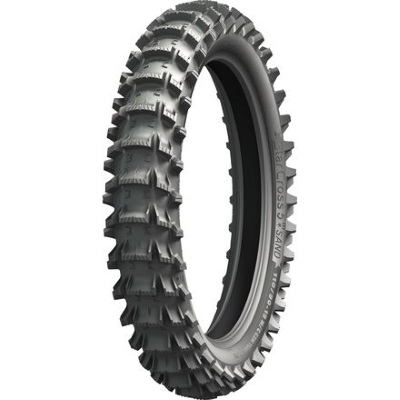
They all look the same. Except those weird smooth ones with a paddle blade spaced out about five inches apart that look more like the drive train for an old sternwheeler.
But mostly dirt bike tires resemble one another... until further inspection. Even then, despite the differing arrangement of knobs, any ole pair it seems will do. That's actually not too far from the truth. Unfortunately, you must also consider compound types. Hard. Soft. Somewhere in between. And if you want to stay upright you might want to consider a tire made specifically for the type of riding planned.
Most riders choose between Motocross tires and off-road since those types represent the most popular form of riding. The paddle tires only work in sand and dual-sport tires work best when traveling on gravel roads, dirt and/or pavement. Dual sport could work for straight trails though you lose some in traction but definitely not advised for racing. Then you have enduro tires which fit on a smaller wheel and handle the gnarliest of terrain.
So, let's filter through some of the more obvious tires. Dune or sand riding requires paddle or sand tires. You will just spin you wheel trying to get traction in sand on a trail or Motocross tire. But some sand tires omit the large paddle and go with a spaced-out knobby pattern that still distinguishes itself from regular riding tires like the Michelin Starcross Sand 5 tire below:
Ok, so how about Dual-Sport? Dirt bike tires for dual-sport riding look in some cases like those equipped on street bikes while others look quite similar to trail or Motocross tires. Check out the Dunlop D606 tires below:
These tires could probably get you around a track and most certainly the trails but actually work best in a dual sport application that function on pavement or highway roads (DOT approval required) but perform best in the dirt. Don't expect the necessary grip for running laps but ride legally on the streets to a nearby trail and let them rip. Other dual sport tires for dirt bikes work best on street by offering a smoother ride on pavement and for use on dirt and gravel roads rather than straight trail like the Shinko Dual Sport 705 tires below:
Now let's tackle the more complicated choice between Motocross, off-road tires and the extreme off-road tire for enduro. Some manufacturers make tires specifically for Motocross while others offer off-road specific. However, most dirt bike tires handle both applications and instead focus on soil conditions. Ideally, you want a specific rubber compound constructing the tire carcass to address the type of soil expected on your ride. A softer compound works on hard and slick surfaces while a hard rubber compound creates a soft terrain tire allowing the tire to secure traction in yielding soil. This Bridgestone Battlecross X40 rear tire functions best on track and trails that contain hard pack:
If loam greets you, then try these Michelin S12 XC tires:
But since most of us work during the week and have fun on the weekends, owning multiple sets of tires (and rims) doesn't usually make sense financially pricing us out of riding altogether - so somewhere in between works best. Thus, intermediate dirt bike tires offer the best of both worlds and most riders stick with intermediate because they can ride velvety soft trails then quickly switch to a blue grooved track with minimal effort. Check out these Dunlop Geomax MX3S intermediate dirt bike tires that grip the slickest hard pack and plant in the softest dirt:
But if you tackle enduro riding you need an altogether different tire made from a different compount than Motocross tires and traditional off-road or trail tires. Enduro dirt bike tires feature a hard compound and a "sticky" compound. The sticky works best for hard terrain with lots of rocks and tree trunks that tend to make regular tires slip. Check out the Artrax XC Enduro "Sticky" Rear Tire with a durometer rating of 50 shores:
However, we recommend the casual racer who enters hometown gate drops use tires based on the soil conditions at the local track but for regional racing an intermediate tire should save you money while gripping varying soil conditions. Those working their way towards Loretta Lynn's probably need to find the means to have several sets of tires because that's what your competition has. The same works for trails. If you ride the same trail system 90 percent of the time make your tire compound choice based on the soil conditions.
What you're saying is generally speaking any tire made for the track or trail works on the other? Yes, but one difference to keep in mind between MX and off-road tires is size. A true Motocross bike runs a 19-inch rear tire and an off-road bike uses an 18-inch tire which offers a bigger side wall for better flexing when rolling over tree roots and rocks, i.e. less flats and more traction. For the difference between an MX bike and an off-road bike check out The Difference Between a Motocross Bike & Trail Bike.
If you ride mostly track and some trails use the 19-inch rear tire but if blazing trails takes up most of your time with occasional track days then stick with the 18-inch rear. Or go all out and own a set of 19-inch and 18-inch rims each equipped with the tire best suited for the track and trail system you roost on.
Get more grip with these other articles related to dirt bike tires:















